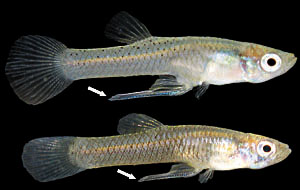 | Scientists found that female mosquito fish reacted more favorably to images of males with digitally enhanced gonopodia (top), but that males with larger gonopodia had more difficulty escaping from pedators. |
Competing evolutionary mechanisms influence male genital size in some fish species, reflecting the tradeoff between a capacity to attract mates and the ability to quickly evade predators, according to a report by scientists from Yale, Washington and Texas A&M universities published in the Proceedings of the National Academy of Sciences.
Variation in the size of male genitalia in animals that have internal fertilization has long been of scientific interest. While competitive advantages of sperm robustness and other post-mating sexual selection criteria have been widely studied and posed as evolutionary explanations for the variations, the roles of pre-mating sexual selection and natural selection have been less well-studied.
Postdoctoral fellow Craig A. Layman in Yale's Department of Ecology and Evolutionary Biology, working with lead investigator Brian Langerhans at Washington University and Thomas J. DeWitt at Texas A&M University, analyzed the gonopodia -- or modified fin that transfers sperm to females -- in western and Bahamas mosquitofish. Mosquitofish cannot retract their gonopodia, and they often display or swing them during courtship.
"Our results suggest that both mating selection, favoring larger genitalia, and natural selection, favoring reduced size, may direct evolution and diversification of genitals," says Layman.
The researchers studied female preference and male swimming performance in the two species of mosquitofish. In laboratory experiments, females preferred to spend time with videos of males displaying digitally enlarged gonopodia rather than those with average-sized gonopodia, implying sexual selection for increased gonopodium size, say the scientists.
Yet the researchers also found that males with larger gonopodia were slower to escape potential predators through evasive swimming bursts.
The research was funded by a Yale Donnelley Environmental Fellowship, a Sustainable Coastal Margins Program Fellowship, a Texas Water Resources Institute Mills Scholarship, an Environmental Protection Agency Science to Achieve Results Fellowship, and a National Science Foundation Grant.
-- By Janet Rettig Emanuel
T H I S
Study shows, when it comes to fish
genitalia, size has pros and cons W E E K ' S
W E E K ' S S T O R I E S
S T O R I E S![]()
 Team creates blood test for 'silent killer'
Team creates blood test for 'silent killer'![]()
![]()
 University marks 100 years of 'Pomp and Circumstance'
University marks 100 years of 'Pomp and Circumstance'![]()
![]()
 Yale scientist featured in new stamp series
Yale scientist featured in new stamp series![]()
![]()
 Twelve honored for strengthening town-gown ties
Twelve honored for strengthening town-gown ties![]()
![]()
 ENDOWED PROFESSORSHIPS
ENDOWED PROFESSORSHIPS Two appointed to Sterling chairs
Two appointed to Sterling chairs![]()
 R. Howard Bloch: French and Medieval Studies
R. Howard Bloch: French and Medieval Studies![]()
 Ian Shapiro: Political science and YCIAS
Ian Shapiro: Political science and YCIAS![]()
 Romano named Ruebhausen Professor
Romano named Ruebhausen Professor![]()
 Waxman is appointed to Flaherty chair
Waxman is appointed to Flaherty chair![]()
 Dr. State has been designated Harris Assistant Professor . . .
Dr. State has been designated Harris Assistant Professor . . .![]()
![]()
 Krauss named to second term at Silliman
Krauss named to second term at Silliman![]()
![]()
 Researchers discover virus' potential to target and kill deadly brain tumor
Researchers discover virus' potential to target and kill deadly brain tumor![]()
![]()
 Yale professors endow teaching and research fund in the history of science
Yale professors endow teaching and research fund in the history of science![]()
![]()
 Study shows, when it comes to fish genitalia, size has pros and cons
Study shows, when it comes to fish genitalia, size has pros and cons![]()
![]()
 Two Yale scientists honored with election to the NAS
Two Yale scientists honored with election to the NAS![]()
![]()
 Six Yale affiliates elected fellows of scholarly society
Six Yale affiliates elected fellows of scholarly society![]()
![]()
 Beijing conference explored Chinese constitutionalism
Beijing conference explored Chinese constitutionalism![]()
![]()
 New scholarship will help nurture future activist ministers
New scholarship will help nurture future activist ministers![]()
![]()
 Yale-IBM computer facility formally dedicated
Yale-IBM computer facility formally dedicated![]()
![]()
 REUNIONS
REUNIONS Alumni will gather for talks, tours and other special events
Alumni will gather for talks, tours and other special events![]()
 Library exhibit celebrates the accomplishments of the Class of '55
Library exhibit celebrates the accomplishments of the Class of '55![]()
 Medical school reunions feature talks on cutting-edge research
Medical school reunions feature talks on cutting-edge research![]()
![]()
 Yale launches research on lung cancer . . .
Yale launches research on lung cancer . . .![]()
![]()
 Workshop will explore technology's power to capture . . .
Workshop will explore technology's power to capture . . .![]()
![]()
 Show features artist's colorful depictions of 'Northern Shores'
Show features artist's colorful depictions of 'Northern Shores'![]()
![]()
 Glen Micalizio wins Beckman Young Investigator award . . .
Glen Micalizio wins Beckman Young Investigator award . . .![]()
![]()
 IN MEMORIAM
IN MEMORIAM Benjamin Mordecai: Drama school teacher and Broadway producer
Benjamin Mordecai: Drama school teacher and Broadway producer![]()
 Memorial service to honor South African historian Leonard Thompson
Memorial service to honor South African historian Leonard Thompson![]()
![]()
 Campus Notes
Campus Notes![]()
Bulletin Home |
| Visiting on Campus
Visiting on Campus |
| Calendar of Events
Calendar of Events |
| In the News
In the News![]()
Bulletin Board |
| Classified Ads
Classified Ads |
| Search Archives
Search Archives |
| Deadlines
Deadlines![]()
Bulletin Staff |
| Public Affairs
Public Affairs |
| News Releases
News Releases |
| E-Mail Us
E-Mail Us |
| Yale Home
Yale Home